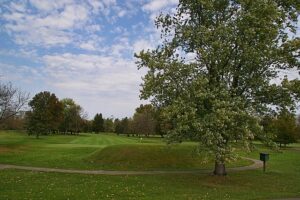
Newark Earthworks, Photo by Niagara66, 16 October, 2011. Listed on the National Register of Historic Places in the USA, reference number 66000614.
How do you reconcile the use, even the respectful use, of ancient earthworks as a private golf course? Will a long-term contractual agreement be determinative? What constitutes good faith in arguments of eminent domain? Which forms of arguments will be considered pertinent – public access, the benefits of future protection, archaeological research potential, or another sort of claim?
A pending U.S. legal case may provide some answers. On April 13, 2021 the Ohio Supreme Court heard oral arguments regarding Case No. 2020-0191 State ex rel. Ohio History Connection v. Moundbuilders Country Club Co. The Court has not yet issued its opinion.
The case involves over four square miles of octagonal, linear, square, and circular earthworks built between 100 BCE and 500 CE by the Hopewell Culture in what is now Newark Ohio. The Newark Earthworks were added to the National Register of Historic Places in 1966 and designated by the State of Ohio as “the official prehistoric monument of the state” in 2006. The site is recognized as “the largest set of geometric earthen enclosures in the world.” The Newark Earthworks have been on the UNESCO tentative list since 2008 as part of Hopewell Ceremonial Earthworks, which includes two other earthwork sites, Hopewell Culture National Historical Park and Fort Ancient State Memorial.
The Moundbuilders Country Club has leased the land for its facilities since 1910, first from the Newark Board of Trade, city of Newark, and Licking County and later from the Ohio State Archeological and Historical Society – now the Ohio History Connection – who acquired the land in 1933.
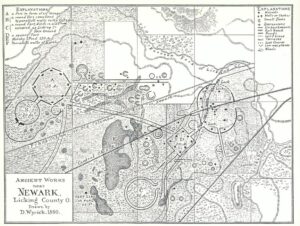
Newark Ohio Drawing by D. Wyrick in 1860.
The Country Club incorporated its golf course into the earthworks from the beginning. Chalmers L. Pancoast wrote about the experience of golfing among the mounds in the January 1930 issue of Golf Illustrated. He began with, “The ancient Moundbuilders unwittingly left behind the setting for as strange and sporty a golf course as ever felt the blow of a niblick,” and continued “There is a certain feeling of adventure in driving balls across the symmetrically shaped mounds, and it is interesting to let the imagination turn back centuries to speculate upon the people who built this prehistoric city, fort, ceremonial amphitheater, or whatever it may have been.” And speculate he does throughout the article as he describes both the intricacies of the earthworks and the interrelationship with the holes of the course, an aspect of the course that is deeply appreciated to this day.
Ohio History Connection, a non-profit incorporated since 1885, and chartered by the state, functions under Section 149.30 of the Ohio Revised Code to “promote a knowledge of history and archaeology, especially of Ohio.” It plans to create a public park that would allow more access for research and visitation to the earthworks. Currently the lease agreement with the Moundbuilders, which extends to 2078, only gives the public complete access four days a year. For the other three hundred sixty-one days of the year visitors to the Octagon Earthworks are restricted to “the interpretive signs/map near the parking lot, the viewing platform, and the path behind the clubhouse to see the Observatory Mound.”
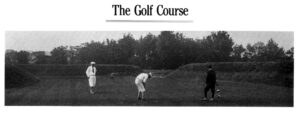
Moundbuilders Golf Course, photo from the Newark Advocate, c 1911.
In the 1930 Golf Illustrated article Pancoast discussed the hazards of visitors exploring the mounds among the golfers. He described his personal experience when he “drove from the eighteenth tee [and nearly hit] two prominent sightseers [who] came from behind the “observation Mound.” [His] ball missed their head by inches. “ He quipped that, ““Fore” naturally was Greek to them.”
“The History Connection [also] tees up examples of the difficulties: spraying of pesticides and herbicides have impaired public visits and research, golf outings have prevented the public from visiting the site, and golfers and flying golf balls have defeated research endeavors,” stated Kathleen Maloney in the Ohio Supreme Court Oral Argument Preview for the case.
In May 2018 the United States Department of the Interior proposed the nomination of the Hopewell Ceremonial Earthworks to the World Heritage List and invited the National Park Service, the State of Ohio, and the Ohio History Connection, to submit the documentation required for nomination. UNESCO notes in its “Statements of authenticity and/or integrity” for Hopewell Ceremonial Earthworks “the Octagon and Great Circle at Newark are also well preserved. There is some intrusion of discordant elements, such as a golf course at the Octagon Earthworks, but the scale of the Hopewell architecture dwarfs these intrusions and the visual unity of the major surviving remnants remains intact and impressive.”
According to Michaela Sumner in the article “Ohio History Connection offers $1.66 million to Newark country club in Octagon Mounds dispute” for the Columbus Dispatch, “During the [Licking County Common Pleas Court] proceedings, the U.S. Department of Interior said it would forward the OHC’s World Heritage nomination only if the golf course had been removed from the site.”
How the case began…

Opening of the Octagon Earthworks in Newark, Ohio. Photo by Nyttend. 17 March 2011.
“The History Connection contacted Moundbuilders Country Club in August 2018 to negotiate a deal for the club’s release of the remaining time on the lease. When the attempt was unsuccessful, the History Connection took steps through its eminent domain power provided in state law to acquire the remaining term on the lease,” Kathleen Maloney stated in the oral argument preview.
She continued, “As an initial step, the History Connection obtained two appraisals. Based on one appraisal, the History Connection formally notified the country club of its intent to acquire the “leasehold interest,” offering $800,000 to compensate the club for the remaining part of the lease and attaching a copy of the appraisal.”
Not receiving a response from the Moundbuilders within 90 days, the History Connection filed a petition in Licking County Common Pleas Court to take back the property through eminent domain and terminate the lease; a move the Moundbuilders argued the History Connection did not have the right to make. They also argued that ending the lease was not necessary and that the offer was less than full market value.
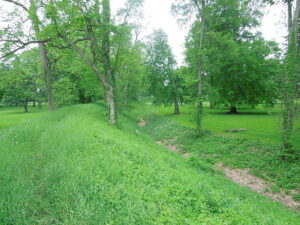
View along the large main wall and the moat from the outside of the Great Circle. The break in the wall – the traditional entrance – is visible in the far distance. Photo by Ericplayzbass, 18 May 2015, CCA-SA 4.0 International license.
The Licking County Common Pleas Court Judge David Branstool ruled in favor of Ohio History Connection in May 2019. “The court noted the approval was the beginning of eminent domain proceedings and, because the parties disagree, would be followed by a valuation stage,” stated Kathleen Maloney.
Before the eminent domain process could proceed, the Moundbuilders Country Club appealed to the Fifth District Court of Appeals, which upheld Judge Branstool’s decision. They then appealed to the Ohio Supreme Court. The Court may take many months to give their opinion. The issues before the court, according to the preview are:
- “Does an authority that is appropriating property meet its burden to make a “good-faith offer” by presenting evidence that it didn’t act in bad faith?”
- “To conclude that the taking of property is necessary for a public purpose, must a court weigh all considerations that impact the public, including weighing competing public interests?”
Hopewell Ceremonial Earthworks: representative of Hopewell Culture
The Hopewell Culture flourished sometime between 100 BCE and 500 CE, extending south into modern day Florida and north into modern day Ontario, Canada. Hopewell culture is characterized by huge burial mounds, astronomically aligned earthworks, and beautifully styled objects made from materials like obsidian, mica, and shells originating from the Yellowstone basin, Appalachia, and the Gulf of Mexico.[1]
Rather than a formally structured hierarchical society, the populations that created the artworks and earthworks are thought to have been a loose collective of family groups that gathered for ceremonies and the creation of ritual space as well as a trade network. Academics have come to call this the Hopewell interaction Sphere. Experts find very little evidence of conflict during this period and think that the structures created served astrological, funerary, and ceremonial functions rather than defensive ones.
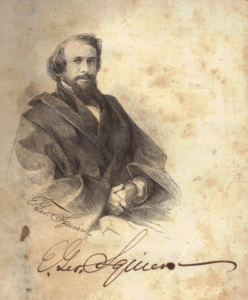
Print by CW of Ephraim George Squier, signed by Squier and presented to N W Bell c. 1870 – 1880. Wikimedia Commons Public Domain.
With the lack of a remembered tradition among tribal nations in the United States, most of what we know about Hopewell culture comes through the work of archeologists. Though not the first to survey many of the Hopewell sites, Edwin H. Davis and Ephraim Squier’s work for the fledgling Smithsonian Institute was the most influential.[2] Their work was memorialized in Ancient Monuments of the Mississippi Valley (1848), the first volume of the “Smithsonian Contributions to Knowledge” series. Ancient Monuments is still used today to inform restoration decisions and archeological research on Hopewell culture.
As previously noted, “The Newark Earthworks are the largest set of geometric earthen enclosures in the world.” They include the Octagon Earthworks at the Moundbuilders Country Club, the 1,200 foot diameter Great Circle Earthworks, and the Wright Earthworks, a fragment of a “geometrically near-perfect square.” These three sites, along with other mounds, walls, and enclosures, were originally connected by a series of parallel walls and spread over four square miles. The Ohio History Connection Newark Earthworks page states, “The complicated array of monumental earthworks [at Newark Earthworks] caused 19th century archaeologists Ephraim Squier and Edwin Davis to despair that it was “impossible to give anything like a comprehensible description of them.””
From the first surveys, archeologists have marveled at the precision of Hopewell earthwork geometry. Squier and Davis were astounded by the geometric accuracy of immense earthwork squares, octagons, and circles, some with circumferences of over a mile. They noted with some astonishment that “the builders possessed a standard of measurement, and had some means of determining angles.”
Squier and Davis continued:
“The most skillful engineer of the day would find it difficult, without the aid of instruments, to lay down an accurate square of the great dimensions of those above represented, measuring as they do more than four fifths of a mile in circumference. It would not, it is true, be impossible to construct circles of considerable size, without instruments; the difficulty of doing so, when we come to the construction of works five thousand four hundred feet, or over a mile in circumference, is nevertheless apparent. But we not only find accurate squares and perfect circles, but also, as we have seen, octagons of great dimensions.” (Ancient Monuments of the Mississippi Valley, p 61)
It wasn’t until the mid 1970s that the Hopewell earthworks’ significance as astronomical markers was discovered, when Earlham College professors Ray Hively and Robert Horn found that elements of the Octagon Earthworks “align with all eight of the key rise- and set-points of the moon during its 18.6-year cycle.” The World Heritage Ohio Hopewell Ceremonial Earthworks webpage states that this is “within a smaller margin of error than that at Stonehenge.”
Hively and Horn said in their March 20, 2020 article for the Newark Advocate, Earthworks: How we found the lunar alignments at the Octagon that they,
“were to find that lunar alignments discovered at the Newark Octagon predicted major design features of Newark and other Ohio Hopewell earthworks. After examining other geometric figures surrounding the Newark Earthworks and their relationship to the local topography, we found over a dozen accurate alignments to the lunar standstills.”
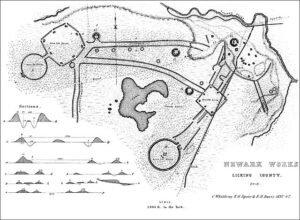
Squier and Davis engraving, plate number XXV, of the Newark Earthworks in Licking County, Ohio, 1848
The largest concentration of earthworks is located about 65 miles southwest of the Newark Earthworks along the Scioto River valley, near Chillicothe, in Ross County Ohio. These are the sites that comprise Hopewell Culture National Historical Park: the archeological research site High Bank Works, the Hopeton Earthworks where 2,400 foot long parallel walls align with the sunset on the winter solstice, the Hopewell Mound Group, which holds the largest known mound constructed by the Hopewell Culture, the fully restored Mound City Group, the Seip Earthworks with the third largest known burial mound constructed by the Hopewell Culture, and the Spruce Hill Earthworks, a stone wall enclosure where concentrations of “intensely burned, fused and glazed stone,” that predated European settlement, have created over a century of speculation as to its origin.
Fort Ancient State Memorial in Warren County, Ohio is the third site of the Hopewell Ceremonial Earthworks on the UNESCO tentative list, chosen for their “Outstanding Universal Value”, authenticity and integrity. The largest pre-Columbian hilltop enclosure in the United State with over 3 ½ miles of earthen walls, Fort Ancient was established in 1891 as Ohio’s first state park. Similarly to other Hopewell sites, research has discredited its function as a defensive structure citing evidence of its ceremonial and astronomical aspects and its poor defensive design.
With the Newark Earthworks a key element of the Hopewell Ceremonial Earthworks and the potential selection of Ohio’s first UNESCO World Heritage Site, it will be interesting to see what the Ohio Supreme Court decides and how the case proceeds from here.
The next two available dates on which to visit the Moundbuilders site are Monday July 26 and Sunday October 17, 2021. These are self guided tours only. Visit the Ohio History Connection website for more information.
[1] Many museums have collections of Hopewell Culture artifacts. In addition to the Ohio History Connection, the British Museum houses a collection that Edwin H. Davis and Ephraim Squier acquired in the course of their work. Davis originally sold the collection to William Henry Blackmore in 1864. Blackmore displayed the artifacts in the Blackmore Museum in Salisbury, Wiltshire, England, which he founded in 1867. The British Museum acquired them sometime after William Blackmore’s brother Humphrey’s death in 1929.
Another notable collection is housed at the Field Museum of Natural History, in Chicago, Illinois. The Ohio Hopewell: Ancient Crossroads of the American Midwest website states, “The Field Museum houses one of the largest archaeological collections of Hopewell Culture artifacts in the world. This collection—primarily from Warren K. Moorehead’s 1891–1892 excavation at the Hopewell Mound Group near Chillicothe, Ohio—dates to the origins of the museum itself. Moorehead’s excavations were undertaken for the 1893 World Columbian Exposition, an event that brought together anthropological materials from around the world and later resulted in the founding of the Field Museum of Natural History.”
[2] For a fascinating account of Squier and Davis’s lives, work, and the conflict that ended their partnership, read A Question of Authorship: The Ephraim George Squier-Edwin Hamilton Davis Controversy, in the Ohio History Journal by the late Terry A. Barnhart, Associate Curator and Director of Special Projects at the Ohio Historical Society, Columbus, Ohio.
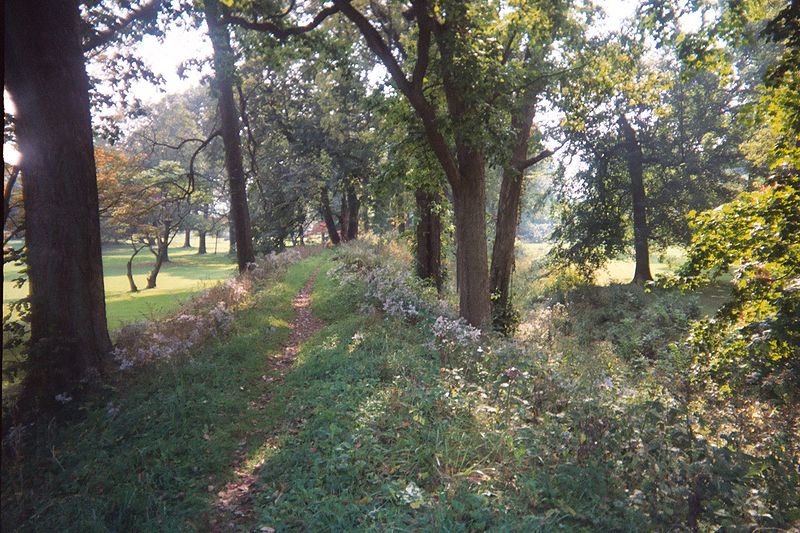 Great Circle Earthworks, part of the Newark Earthworks in Newark, Ohio, built by the Hopewell culture from 100 BC to 500 AD. Photo by Ebyabe, 27 September 2004. CCA-SA 3.0 license.
Great Circle Earthworks, part of the Newark Earthworks in Newark, Ohio, built by the Hopewell culture from 100 BC to 500 AD. Photo by Ebyabe, 27 September 2004. CCA-SA 3.0 license. 

